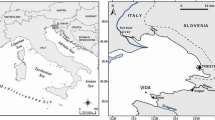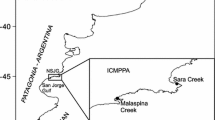Abstract
Anoxic degradation of sedimentary biogenic debris using closed sediment incubation experiments was studied in eutrophic subalpine Lake Bled (NW Slovenia) which, for most of the year, has an anoxic hypolimnion. Production rates of dissolved inorganic carbon (DIC), NH4 +, PO4 3- and dissolved Si, and reduction rates of SO4 2- were measured and anoxic mineralization rates were modelled using G-model. The depth profiles indicated major mineralization of biogenic debris and SO4 2- reduction near the sediment surface. A comparison between depth integrated anoxic mineralization rates and diffusive benthic fluxes of DIC, NH4 + and PO4 3- showed that the anoxic incubation experiments provide a good estimate of N degradation of biogenic debris. The contributions of SO4 2- reduction and acetate fermentation in NH4 + production are about 30 and 70%, respectively. The DIC production accounted for only 15% of DIC benthic flux, indicating that methanogenesis and oxidation of methane provides 80% of this flux. Only about 30% of PO4 3- was released because phosphate precipitated in the closed incubation experiments. The depth integrated production of Si accounts for 70–80% of Si benthic fluxes indicating intense dissolution of biogenic Si in the surficial lake sediment.
Similar content being viewed by others
References
Aller, R. C. & J. Y. Yingst, 1980. Relationship between microbial distributions and the anaerobic decomposition of organic matter in surface sediments of Long Island Sound. Mar. Biol. 56: 29-42.
Berner, R. A., 1966. Chemical diagenesis of somemodern carbonate sediments. Am. J. Sci. 264: 1-36.
Berner, R. A., 1980. Early Diagenesis. A Theoretical Approach. Princeton University Press, Princeton, New York.
Burdige, D. J., 1991. The kinetics of organic matter mineralization in anoxic marine sediments. J. mar. Res. 49: 727-761.
Cermelj, B., J. Faganeli, B. Ogorelec, T. Dolenec, J. Pezdic & B. Smodis, 1996. The origin and recycling of sedimented biogenic debris in a subalpine eutrophic lake (Lake Bled, Slovenia). Biogeochem. 32: 69-91.
Furrer, G. & B. Wehrli, 1996. Microbial reactions, chemical speciation, and multicomponent diffusion in porewaters af a eutrophic lake. Geochim. Cosmochim. Acta 60: 2333-2346.
Gachter, R. & B. Wehrli, 1990. Mechanisms controlling fluxes of nutrients across the sediment/water interface in a eutrophic lake. In Bands, R. & J. Giesy (eds), Fates and Effect of In-Place of Pollutants in Aquatic Ecosystems. Lewis Publ., Ann Arbor: 131- 162.
Gieskes, J. M. & W. C. Rogers, 1973. Alkalinity determination in interstitial waters of marine sediments. J. Sediment Petrol. 43: 272-277.
Grasshoff, K., M. Ehrhardt & K. Kremling, 1983. Methods in seawater analysis, Verlag Chemie, Weinheim.
Krom., M. D. & R. A. Berner, 1980. Adsorption of phosphate in anoxic marine sediments. Limnol. Oceanogr. 25: 797-806.
Lawson, S. D., D. C. Hurd & H. Stuart Pankratz, 1978. Silica dissolution rates of decomposing phytoplankton assemblages at various temperatures. Am. J. Sci. 278: 1373-1393.
Lerman, A., 1979. Geochemical Processes: Water and Sediment Environments. John Wiley & Sons, New York.
Li, Y. H. & S. Gregory, 1974. Diffusion of ions in sea water and deep-sea sediments. Geochim. Cosmochim. Acta 38: 703-714.
Lojen, S., N. Ogrinc & T. Dolenec, 1999. Decomposition of sedimentary organic matter and methane formation in the recent sediment of Lake Bled (Slovenia). Chem. Geol. 159: 223-240.
Mackin, J. E. & R. C. Aller, 1984. Ammonium adsorption in marine sediments. Limnol. Oceanogr. 29: 250-257.
Meischner, D. & J. Rumohr, 1974. A light-weight high-momentum gravity corer for subaqueous sediments. Senckenb. Marit. 6: 105-117.
Millero, F., 1995. Thermodynamics of the carbon dioxide system in the oceans. Geochim. Cosmochim. Acta 59: 661-677.
Muri, G., B. Cermelj, J. Faganeli & J. Holc, 2002. Determination of black carbon in lacustrine and coastal marine sediments by thermal oxidation. Acta Chim. Slov. 49: 29-42.
Ogrinc, N., S. Lojen & J. Faganeli, 1997. The sources of dissolved inorganic carbon in pore waters of lacustrine sediment. Water Air Soil Pollut. 99: 333-341.
Tabatabai, M. A., 1974. A rapid method for determination of sulfate in water samples. Environ. Lett. 7: 237-243.
Van Cappellen, P. & R. A. Berner, 1988. A mathematical model for the early diagenesis of phosphorus and fluorine in marine sediments: apatite precipitation. Am. J. Sci. 288: 289-333.
Westrich, J. T. & R. A. Berner, 1984. The role of sedimentary organic matter in bacterial sulfate reduction: the G model tested. Limnol. Oceanogr. 29: 236-249.
Wollast, R., 1974. The silica problem. In Golberg, E. D. (ed.), The Sea. Vol. 5, Wiley-Interscience, New York: 359-392.
Author information
Authors and Affiliations
Rights and permissions
About this article
Cite this article
Cermelj, B., Faganeli, J. Anoxic degradation of biogenic debris in sediments of eutrophic subalpine Lake Bled (Slovenia). Hydrobiologia 494, 193–199 (2003). https://doi.org/10.1023/A:1025466315886
Issue Date:
DOI: https://doi.org/10.1023/A:1025466315886




